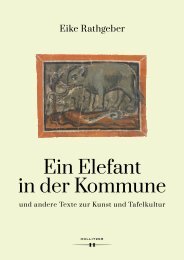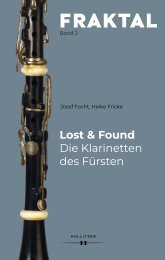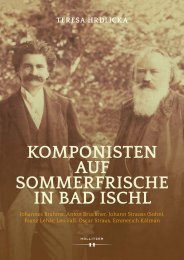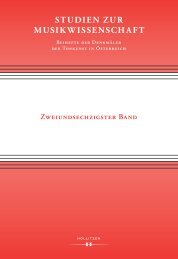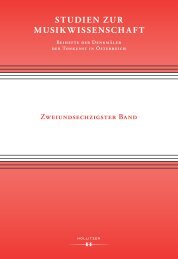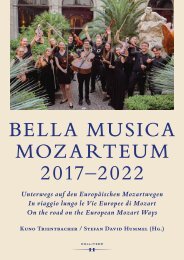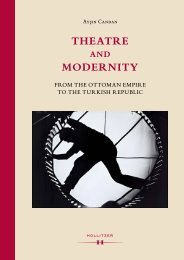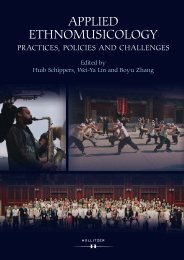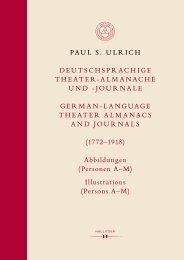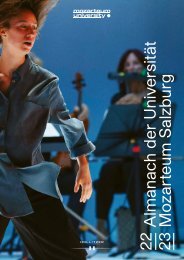Create successful ePaper yourself
Turn your PDF publications into a flip-book with our unique Google optimized e-Paper software.
HOLLITZER<br />
CATALOGUE<br />
OF PUBLICATIONS<br />
Book Series<br />
<strong>Ottomania</strong><br />
Ottoman Empire &<br />
European Theatre<br />
Don Juan Archiv Wien
www.hollitzer.at<br />
www.donjuanarchiv.at<br />
2 Hollitzer Verlag Catalogue of Publications <strong>Ottomania</strong> by Don Juan Archiv Wien
<strong>Ottomania</strong><br />
Ottoman Empire &<br />
European Theatre<br />
“In Turchia novantuna”<br />
Dramatic and literary Don Juan figures such as<br />
Tenorio, Tabarca and their like are linked to the<br />
‘Turkish sujet’ through the 1571 victory of the united<br />
Spanish-Genovese-Papal-Venetian fleet over the<br />
Ottoman fleet at Lepanto, under the “Generalissimo<br />
di mare” Don Juan de Austria, the historic ‘role<br />
model’ for Don Juan on stage. Acts of war by Tirso,<br />
character demeanours by Molière, erotic adventures<br />
by da Ponte as listed by Leporello – and decoded<br />
and encoded anew by Lord Byron – are all part of this<br />
link. The series <strong>Ottomania</strong>, along with a sub-series<br />
Ottoman Empire & European Theatre, are dedicated<br />
to the relations between Europe and the Ottoman<br />
Empire, primarily in the field of mutual cultural<br />
exchange.<br />
The series was founded in 2013<br />
Series Editors:<br />
Vol. 1–8:<br />
Michael Hüttler<br />
Hans Ernst Weidinger<br />
Vol. 9–12:<br />
Michael Hüttler<br />
Suna Suner<br />
Hans Ernst Weidinger<br />
ISSN 2617-2542<br />
Hardcover with dust jacket<br />
b/w with spotcolour<br />
colour images<br />
The book series <strong>Ottomania</strong> by Don Juan Archiv<br />
Wien researches the cultural transfers between the<br />
Ottoman Empire and Europe with a focus on the<br />
performing arts. The symposia proceedings Ottoman<br />
Empire and European Theatre – based on symposia<br />
held in Vienna and Istanbul between 2008 and<br />
2015 – emphasize the various theatrical and musical<br />
expressions of the exponents of the Ottoman<br />
Empire, presented on the theatrical stages of Europe,<br />
as well as the appearance of European theatre and<br />
opera in the Ottoman Empire, especially in its capital<br />
and political as well as cultural centre, Istanbul.<br />
Few publications on the topic of the cultural connections<br />
between the Ottoman Empire and Europe<br />
focus on theatre and opera; fewer still have engaged<br />
the topic of the interaction and reciprocal influences<br />
of the Ottoman Empire and European theatre<br />
before 1800. That gap in research is addressed<br />
by this new series.<br />
Hollitzer Verlag Catalogue of Publications <strong>Ottomania</strong> by Don Juan Archiv Wien<br />
3
OTTOMANIA 1<br />
A focus on Ottoman Empire and Euro pean<br />
Theatre between 1756 and 1808, the time<br />
of W. A. Mozart and Sultan Selim III<br />
NIA<br />
EUROPEAN THEATRE I<br />
OTTOMAN EMPIRE<br />
AND<br />
EUROPEAN THEATRE<br />
I<br />
THE AGE OF<br />
MOZART AND SELIM III<br />
(1756 –1808)<br />
edited by<br />
MICHAEL HÜTTLER · HANS ERNST WEIDINGER<br />
W. A. Mozart (1756–1791) and Sultan<br />
Selim III (1761–1808): These historical<br />
DON JUAN ARCHIV WIEN is an independent research<br />
personalities, whose life-spans overlap,<br />
institute for opera and theatre history in Central and<br />
were Mediterranean towering Europe from figures the beginnings of to their nineteenth<br />
century.<br />
time:<br />
Mozart as an extraordinary composer<br />
Don Juan is an important figure in cultural and theatre<br />
and Selim III as both a politician and<br />
history, originating in Spain in the early seventeenth century,<br />
a composer. becoming increasingly Inspired widespread in Europe by and the since structure<br />
the<br />
late eighteenth century continuously disseminated overseas.<br />
of opera, the forty-four contributions<br />
The numerous traces of this theatrical triumphal procession<br />
are<br />
are<br />
arranged<br />
being systematically<br />
in<br />
catalogued<br />
eight<br />
and<br />
sections.<br />
documented by<br />
Topics<br />
the DON JUAN ARCHIV WIEN. A particular focus is<br />
covered Lorenzo da in Ponte Act and W. I–5 A. Mozart’s are Don among Giovanni (Pra-othergue,<br />
1787) – its genesis and premiere, the performances<br />
“The Stage of Politics”, “Diplomacy and<br />
involving its authors, and its reception.<br />
Theatre”, “Mozart and ‘Turkishness’”<br />
DON JUAN ARCHIV WIEN is a member of several international<br />
“Sultan organisations, Selim such as III: SIBMAS A and Man IAML, and of Letters<br />
and<br />
collaborates with archives, libraries, museums, and research<br />
and Arts”.<br />
institutions – particularly in Vienna, Salzburg, Prague, Florence<br />
and Rome. The archive fosters academic and artistic<br />
exchanges on both a regional and international level<br />
through numerous events like conferences, workshops,<br />
dialogue meetings, lectures, and notably the series of<br />
symposia Ottoman Empire and European Theatre, which<br />
has been held since 2008. In addition, the DON JUAN<br />
ARCHIV WIEN has presented its research in the form of<br />
publications that are generally published by HOLLITZER<br />
Wissenschaftsverlag.<br />
The book series “<strong>Ottomania</strong>” researches the cultural transfers<br />
between the Ottoman Empire and Europe with a focus<br />
on the performing arts.<br />
Michael Hüttler (* 1966) has been conducting<br />
research for Don Juan Archiv Wien since<br />
2001. Since 2010 he has been head of the<br />
then founded HOLLITZER Verlag.<br />
Hans Ernst Weidinger (* 1949) studied law,<br />
classical languages, theatre studies<br />
and art history in Vienna and founded<br />
the Don Juan Archiv Wien in 1987.<br />
Michael Hüttler / Hans Ernst Weidinger (eds.)<br />
Ottoman Empire and European Theatre I.<br />
The Age of Mozart and Selim III (1756–1808)<br />
2013 | <strong>Ottomania</strong> 1<br />
ISBN 978-3-99012-065-1<br />
1036 pages | 17,5 × 24,5 cm<br />
English<br />
Hardcover with dustjacket<br />
€ 82,50<br />
also available as e-book<br />
€ 49,99<br />
4 Hollitzer Verlag Catalogue of Publications <strong>Ottomania</strong> by Don Juan Archiv Wien
OTTOMANIA 1<br />
<strong>Ottomania</strong> 1 Ottoman Empire & European Theatre 1<br />
The Age of Mozart and Selim III<br />
Hans Ernst Weidinger (Vienna): Don Juan,<br />
Ottoman Empire and European Theatre: A Proem<br />
Ouverture<br />
Michael Hüttler (Vienna) and Hans Ernst Weidinger<br />
(Vienna/Florence): Editorial<br />
Michael Hüttler (Vienna): Orientalism on Stage:<br />
Historical Approaches and Scholarly Reception<br />
Zeynep Oral (Istanbul): In Memoriam Leyla Gencer<br />
Prologue: The Stage of Politics<br />
Bertrand Michael Buchmann (Vienna): Austria’s Relations<br />
with the Ottoman Empire in the Eighteenth Century<br />
Mehmet Alaaddin Yalçınkaya (Trabzon): The Ottoman<br />
Empire and Europe in the Wake of the Second Half of<br />
the Eigteenth Century<br />
Act I: Diplomacy and Theatre<br />
Suna Suner (Istanbul/Vienna): The Earliest Opera<br />
Performances in the Ottoman World and the<br />
Role of Diplomacy<br />
Walter Puchner (Athens): European Drama and Theatre<br />
in Seventeenth-Century Istanbul<br />
B. Babür Turna (Ankara): The Watcher and the Watched:<br />
Eighteenth-Century Ottoman Diplomatic Visitors in<br />
Europe as Spectator and ‘Performer’<br />
Günsel Renda (Istanbul): The European Ambassadors<br />
at the Ottoman Court: The Imperial Protocol<br />
Frank Huss (Vienna): “Auf türkische Art prächtig<br />
aufgeputzt”: The Visit to Vienna by the Extraordinary<br />
Ottoman Envoy, Chaddi Mustafa Efendi (1748)<br />
William F. Parmentier II (Istanbul): The Mehter:<br />
Cultural Perceptions and Interpretations of Turkish<br />
Drum and Bugle Music Throughout History<br />
Act II: Europe South, West and North<br />
Alexandre Lhâa (Aix-en-Provence): Performing<br />
‘Turkish Rulers’ on the Teatro alla Scala’s Stage: From<br />
the Late Eighteenth to the Mid Nineteenth Century<br />
Esin Akalin (Istanbul): The Ottoman Seraglio on<br />
European Stages<br />
Emre Aracı (London): “Help for the Turk”: Investigating<br />
Ottoman Musical Representations in Britain from<br />
the Late Eighteenth to the Mid Nineteenth Century<br />
Bent Holm (Copenhagen): The Staging of the Turk: The<br />
Turk in the Danish Theatre of the Eighteenth Century<br />
Isabelle Moindrot (Paris): The ‘Turk’ and the ‘Parisienne’:<br />
From Favart’s Soliman second, ou Les trois sultanes<br />
(1761) to Les Trois Sultanes (Pathé, 1912)<br />
Act III: Central Europe<br />
Thomas Betzwieser (Bayreuth): Ottoman Representation<br />
and Theatrical alla turca<br />
Michael Hüttler (Vienna): ‘Turks’ on the Late Eighteenth<br />
Century’s Viennese Stage<br />
Matthias J. Pernerstorfer (Vienna): The Second Turkish<br />
Siege of Vienna (1683) Reflected in its First Centenary:<br />
‘Anniversary Plays’ in the Pálffy Theatre Library, Vienna<br />
Erich Duda (Vienna): Mozart’s Pupil and Friend: Franz<br />
Xaver Süssmayr’s Sinfonia Turchesca, Il Turco in Italia,<br />
and Soliman der Zweite<br />
Gabriele C. Pfeiffer (Vienna): Freemason, Mozart’s<br />
Contemporary, and Theatre Director on the Edge:<br />
Franz Kratter (1758–1830) and Der Friede am Pruth<br />
(1799). Cataloguing the Komplex Mauerbach, Vienna<br />
Act IV: Mozart<br />
Matthew Head (London): ‘In the Orient of Vienna’:<br />
Mozart’s ‘Turkish’ Music and the Theatrical Self<br />
Marianne Tråvén (Uppsala): Mozart’s ‘Turkish’ Operas<br />
and the Emotive Aspect of Slavery<br />
Derek Weber (Vienna): From Zaide to Die Entführung<br />
aus dem Serail: Mozart’s ‘Turkish’ Operas<br />
Nadja Kayali (Vienna): Mozart’s ‘Orient’ on Stage<br />
Annemarie Bönsch (Vienna): ‘Turkish’ and ‘Exotic’<br />
References in the European Fashion<br />
Selin İpek (Istanbul): European Influences on<br />
Eighteenth-Century Ottoman Imperial Fashion<br />
Käthe Springer-Dissmann (Vienna): Mozart Goes to<br />
Constantinople! The Conditions of a Fictitious Journey<br />
Act V: Sultan Selim III<br />
Tülay Artan (Istanbul): A Composite Universe: Arts and<br />
Society in Istanbul at the End of the Eighteenth Century<br />
Caroline Herfert (Vienna): ‘German Poet and Turkish<br />
Diplomat’: Murad Efendi and the Tragedy Selim der<br />
Dritte<br />
Günsel Renda (Istanbul): Selim III as Patron of the Arts<br />
Mustafa Fatih Salgar (Istanbul): Selim III as a Man of<br />
Letters and Art<br />
Ayşın Candan (Istanbul): The Play World of Selim III<br />
Epilogue: The Hero in the Sultan’s Harem<br />
Ulrike Schneider (Weimar): Between Enlightenment<br />
and Orient: Oberon by Christoph Martin Wieland<br />
Hans-Peter Kellner (Copenhagen): From The Prince<br />
of Denmark in the Sultan’s Harem to Don Juan in<br />
the Royal Danish Chambers: The Forgotten Composer<br />
Friedrich Ludwig Aemilius Kunzen (1761–1817)<br />
Hollitzer Verlag Catalogue of Publications <strong>Ottomania</strong> by Don Juan Archiv Wien<br />
5
OTTOMANIA 2<br />
For centuries the figure of “the Turk”<br />
spread fascination and fear –<br />
in the theatre of war and on stage<br />
OTTOMANIA<br />
2<br />
Bent Holm<br />
THE TAMING OF THE TURK<br />
Bent Holm<br />
THE TAMING<br />
OF<br />
THE TURK<br />
OTTOMANS ON THE<br />
DANISH STAGE 1596–1896<br />
translated from the Danish by<br />
Gaye Kynoch<br />
From the staging of “the Turk” as a<br />
diabolical player in royal ceremonies of<br />
early modern times, to the appearance<br />
DON JUAN ARCHIV WIEN is an independent research<br />
of<br />
institute<br />
harmless<br />
for opera and<br />
“Turkish”<br />
theatre history in Central<br />
entertainment<br />
and<br />
Mediterranean Europe from the beginnings to the nineteenth<br />
figures century. in the late nineteenth century.<br />
Artistic,<br />
Don Juan is an<br />
theatrical<br />
important figure in cultural<br />
and<br />
and<br />
theo<br />
theatre<br />
logical<br />
history, originating in Spain in the early seventeenth century,<br />
conceptions co-act in paradoxical ways<br />
becoming increasingly widespread in Europe and since the<br />
against late eighteenth century a backdrop continuously disseminated of pragmatic overseas. connections<br />
are being systematically with catalogued and Ottomans. documented by the The book<br />
The numerous traces of this theatrical triumphal procession<br />
DON JUAN ARCHIV WIEN.<br />
elucidates, for the first time, three<br />
centuries DON JUAN ARCHIV of cultural WIEN is a member history of several as articulated<br />
collaborates in dealings with archives, libraries, between museums, and research the Kingdom<br />
international organisations, such as SIBMAS and IAML, and<br />
institutions – particularly in Vienna, Salzburg, Prague,<br />
of Denmark and the Ottoman Empire<br />
Florence and Rome. The archive fosters academic and artistic<br />
seen<br />
exchanges<br />
in<br />
on both<br />
a<br />
a<br />
general<br />
regional and international<br />
European<br />
level through<br />
context.<br />
numerous events like conferences, workshops, dialogue<br />
meetings, lectures, and notably the series of symposia<br />
Ottoman Empire and European Theatre, which has been held<br />
since 2008. In addition, the DON JUAN ARCHIV WIEN<br />
has presented its research in the form of publications that are<br />
published by HOLLITZER Wissenschaftsverlag.<br />
The book series “<strong>Ottomania</strong>” researches the cultural<br />
transfers between the Ottoman Empire and Europe with a<br />
focus on the performing arts.<br />
Michael Hüttler and Hans Ernst Weidinger (eds.): Ottoman<br />
Empire and European Theatre, vol. 1: The Age of Mozart and<br />
Selim III (1756-1808), 2013 (= <strong>Ottomania</strong> 1)<br />
Bent Holm (* 1946) was until 2014 associate<br />
professor at the Institute for Arts and<br />
Cultural Studies, University of Copenhagen.<br />
Research travels led him to Italy, France<br />
and India. He published interdisciplinary<br />
studies on historical and dramaturgical issues.<br />
Bent Holm<br />
The Taming of the Turk.<br />
Ottomans on the Danish Stage 1596–1896<br />
Translated from the Danish by Gaye Kynoch<br />
2014 | <strong>Ottomania</strong> 2<br />
ISBN 978-3-99012-118-4<br />
348 pages | 17,5 × 24,5 cm<br />
English<br />
Hardcover with dustjacket<br />
€ 55,00<br />
21.5.2014 9:43:00<br />
also available as e-book<br />
€ 39,99<br />
6 Hollitzer Verlag Catalogue of Publications <strong>Ottomania</strong> by Don Juan Archiv Wien
OTTOMANIA 2<br />
<strong>Ottomania</strong> 2<br />
The Taming of the Turk<br />
Introduction<br />
Perceptions of ‘the Turk’<br />
Them and Us<br />
The Graveyard of Culture – the Scrapheap of History<br />
The Kaleidoscope of History<br />
Identity and Staging<br />
Images and Voices<br />
Chapter 1<br />
Sixteenth and Seventeenth Centuries:<br />
Conspiracy and Apocalypse<br />
War and Coronation<br />
The Turk and the Pope<br />
Heresy and Nonbelief<br />
The Tamed Turk<br />
Popular Belief and ‘the Enemy’<br />
Chapter 3<br />
The Nineteenth Century:<br />
Carnival and Casino<br />
Exotic Romanticism<br />
The Turk in the Cage<br />
Portrait of the Artist as Young Woman<br />
The Near East<br />
The Pope, the Turk and the German<br />
Far from Denmark?<br />
Harem and History<br />
Afterword<br />
Synthesis and Retraction<br />
Interplay and Openness<br />
Symbol and Stereotype<br />
Prophecy and Polyphony<br />
Chapter 2<br />
The Eighteenth Century:<br />
Parody and Pedagogy<br />
War and Masquerade<br />
Parody and Paranoia<br />
The Commercial Stage<br />
The Theatrical Stage<br />
The New Turk<br />
The Turk in Paris<br />
The Turk in Vienna<br />
The Turk in Copenhagen<br />
The Dane and the Turk<br />
The Christian Knight<br />
Nation at War<br />
The Swede and the Turk<br />
The Turk and the People<br />
The Real Seraglio<br />
Far from Farce?<br />
Appendix<br />
Select Bibliography<br />
Index<br />
Hollitzer Verlag Catalogue of Publications <strong>Ottomania</strong> by Don Juan Archiv Wien<br />
7
OTTOMANIA 3<br />
An exploration of the relationship<br />
between Western artists<br />
and Turkish-Ottoman culture<br />
OMANIA<br />
3<br />
OTTOMAN EMPIRE AND<br />
EUROPEAN THEATRE II<br />
OTTOMAN EMPIRE<br />
AND<br />
EUROPEAN THEATRE<br />
II<br />
THE TIME OF JOSEPH HAYDN:<br />
FROM SULTAN MAHMUD I<br />
TO MAHMUD II (r.1730–1839)<br />
edited by<br />
Michael Hüttler ∙ Hans Ernst Weidinger<br />
Twenty-seven contributions<br />
by renowned experts shed light on<br />
DON JUAN ARCHIV WIEN is an independent research<br />
the mutual influences that affected<br />
institute for opera and theatre history in Central and<br />
European Mediterranean Europe and from the Ottoman beginnings to the society<br />
nineteenth<br />
century.<br />
and art in the 18th-century. Ottoman<br />
Don Juan is an important figure cultural and theatre<br />
artists have been interested in European<br />
becoming culture, increasingly widespread as well in Europe as and Western<br />
since the<br />
history, originating in Spain in the early seventeenth century,<br />
late eighteenth century continuously disseminated overseas.<br />
playwrights, The numerous traces of this composers theatrical triumphal procession and visual<br />
are being systematically catalogued and documented by the<br />
artists in the Turkish-Ottoman culture.<br />
DON JUAN ARCHIV WIEN.<br />
The articles reflect the growth of<br />
DON JUAN ARCHIV WIEN is a member of several<br />
research<br />
international organisations,<br />
in the<br />
such<br />
area<br />
as SIBMAS<br />
of<br />
and<br />
cultural<br />
IAML, and<br />
transfers<br />
collaborates with archives, libraries, museums, and research<br />
between the Ottoman Empire and<br />
institutions – particularly in Vienna, Salzburg, Prague,<br />
non-Ottoman Florence and Rome. The archive Europe, fosters academic as and expressed<br />
artistic<br />
exchanges on both a regional and international level through<br />
in theatre, music and the visual arts.<br />
numerous events like conferences, workshops, dialogue<br />
meetings, lectures, and notably the series of symposia Ottoman<br />
Empire and European Theatre, which has been held since 2008.<br />
In addition, the DON JUAN ARCHIV WIEN has presented<br />
its research in the form of publications that are published by<br />
HOLLITZER Wissenschaftsverlag.<br />
The book series “<strong>Ottomania</strong>” researches the cultural transfers<br />
between the Ottoman Empire and Europe with a focus on the<br />
performing arts.<br />
Michael Hüttler and Hans Ernst Weidinger (eds.): Ottoman<br />
Empire and European Theatre, vol. 1: The Age of Mozart and<br />
Selim III (1756–1808), 2013 (= <strong>Ottomania</strong> 1)<br />
Bent Holm: The Taming of the Turk: Ottomans on the Danish<br />
Stage 1596–1896, 2014 (= <strong>Ottomania</strong> 2).<br />
Michael Hüttler (* 1966) has been conducting<br />
research for Don Juan Archiv Wien since<br />
2001. Since 2010 he has been head of the<br />
then founded HOLLITZER Verlag.<br />
Hans Ernst Weidinger (* 1949) studied law,<br />
classical languages, theatre studies<br />
and art history in Vienna and founded<br />
the Don Juan Archiv Wien in 1987.<br />
Michael Hüttler / Hans Ernst Weidinger (eds.)<br />
Ottoman Empire and European Theatre II.<br />
The Time of Joseph Haydn: From Sultan Mahmud I<br />
to Mahmud II (r.1730–1839)<br />
2014 | <strong>Ottomania</strong> 3<br />
ISBN 978-3-99012-068-2<br />
736 pages | 17,5 × 24,5 cm<br />
English<br />
Hardcover with dustjacket<br />
€ 77,00<br />
13.5.2014 19:07:06<br />
also available as e-book<br />
€ 44,99<br />
8 Hollitzer Verlag Catalogue of Publications <strong>Ottomania</strong> by Don Juan Archiv Wien
OTTOMANIA 3<br />
<strong>Ottomania</strong> 3 Ottoman Empire & European Theatre 2<br />
The Time of Joseph Haydn<br />
Ouverture<br />
Michael Hüttler (Vienna) and Hans Ernst Weidinger<br />
(Vienna/Florence): Editorial Forewords<br />
Prologue: Politics<br />
Mehmet Alaaddin Yalçınkaya (Trabzon): The Recruitment<br />
of European Experts for Service in the Ottoman Empire<br />
(1732–1808)<br />
Bertrand Michael Buchmann (Vienna): Austria and the<br />
Ottoman Empire between 1765 and 1815<br />
Act I: Fashion and Diplomacy<br />
Annemarie Bönsch (Vienna): From Aristocratic to<br />
Bourgeois Fashion in the Eighteenth Century<br />
Suna Suner (Vienna): Of Messengers, Messages and<br />
Memoirs: Opera and the Eighteenth-Century Ottoman<br />
Envoys and Their Sefâretnâmes<br />
Çetin Sarıkartal (Istanbul): Two Turkish-Language<br />
Plays Written by Europeans at the Academy of Oriental<br />
Languages in Vienna During the Age of Haydn<br />
Intermezzo I<br />
Walter Puchner (Athens): Karagöz and the History<br />
of Ottoman Shadow Theatre in the Balkans<br />
Act II: Books in and about the Ottoman Empire<br />
Orlin Sabev (Orhan Salih, Sofia): European Printers<br />
in Istanbul During Joseph Haydns's Era: İbrahim<br />
Müteferrika and Others<br />
Geoffrey Roper (London): Music, Drama and<br />
Orientalism in Print: Joseph von Kurzböck (1736–1792),<br />
His Predecessors and Contemporaries<br />
Reinhard Buchberger (Vienna): The Austro-Turkish<br />
War of 1788–1791 as Reflected in the Library of the<br />
Viennese Bibliophile Max von Portheim<br />
Intermezzo II<br />
Käthe Springer-Dissmann (Vienna): Did Mozart Drive<br />
a ‘Haydn’? Cartwrights, Carriages and the Postal<br />
System in the Austrian-Hungarian Border Area<br />
Act III: The Esterház Stage<br />
Larry Wolff (New York): Turkish Travesty in European<br />
Opera: Haydn’s Lo speziale (1768)<br />
Caryl Clark (Toronto): Encountering ‘Others’ in Haydn’s<br />
Lo speziale (1768)<br />
Necla Çıkıgil (Ankara): Haydn’s Humour Reflected<br />
in Lo speziale (1768) and L’incontro improvviso (1775)<br />
Matthew Head (London): Interpreting ‘Abduction’<br />
Opera: Haydn’s L’incontro improvviso, Sovereignty<br />
and the Esterház Festival of 1775<br />
Intermezzo III<br />
Clemens Zoidl (Vienna): A Royals’ Journey in 1775:<br />
The Vienna Official Press Review<br />
Act IV: The French Influence<br />
Daniel Winkler (Vienna): Crusaders, Love and Tolerance:<br />
Tragic and Operatic Taste in and Around Voltaire’s Zaïre<br />
(1732)<br />
Hans-Peter Kellner (Copenhagen): The Sultan of<br />
Denmark: Voltaire’s Zaïre and King Christian VII<br />
(r.1766–1808) – Madness and Enlightenment<br />
Bent Holm (Copenhagen): Occidental Portraits in Oriental<br />
Mirrors: The Ruler Image in the Eighteenth-Century<br />
Türkenoper and Gluck’s La Rencontre Imprévue<br />
Isabelle Moindrot (Tours): Tamerlan: A ‘Turkish’ Opera<br />
by Peter von Winter for the Paris Opera (1802)<br />
Intermezzo IV<br />
Netice Yıldız (North Cyprus): Turkish Britons and<br />
Ottoman Turks in England During the Eighteenth<br />
Century<br />
Act V: The Ottoman Stage<br />
Günsel Renda (Istanbul): Westernisms and Ottoman<br />
Visual Culture: Wall Paintings<br />
Caroline Herfert (Vienna): Selim III and Mahmud II in<br />
the Limelight: Imparting Knowledge on the Ottoman<br />
Empire from the Perspective of the ‘Viennese Turk’<br />
Murad Efendi (1836–1881)<br />
Emre Aracı (London): “Each Villa on the Bosphorus<br />
Looks a Screen | New Painted, Or a Pretty Opera<br />
Scene”: Mahmud II (r.1808–1839) Setting the Ottoman<br />
Stage for Italian Opera and Viennese Music<br />
Adam Mestyan (Cambridge/MA): SOund, Military Music,<br />
and Opera in Egypt during the Rule of Mehmet Ali<br />
Pasha (r.1805–1848)<br />
Epilogue<br />
“The Ladies of Vienna En Masse Waited Upon the<br />
Turkish Ambassador to Compliment Him ...”:<br />
Excerpts From Frances Trollope’s Vienna and the<br />
Austrians (1838)<br />
Hollitzer Verlag Catalogue of Publications <strong>Ottomania</strong> by Don Juan Archiv Wien<br />
9
OTTOMANIA 4<br />
Walter Puchner erforscht die letzten<br />
Zeugen einer einst im ganzen östlichen<br />
Mittelmeer verbreiteten Spieltätigkeit<br />
OTTOMANIA<br />
4<br />
DAS NEU GRIE CHISCHE<br />
SCHATTENT HEATER K ARA GIOZIS<br />
DAS NEUGRIECHISCHE<br />
SCHATTENTHEATER<br />
K ARAGIOZIS<br />
Die Forschungen am neugriechischen<br />
Schattentheater führten Walter<br />
Puchner in zentrale Bereiche von<br />
Das DON JUAN ARCHIV WIEN ist eine private<br />
Theaterwissenschaft Forschungsinstitution, die sich der und Opern- Neogräzistik.<br />
und<br />
Theatergeschichte Zentral- und Mediterran-Europas von den<br />
Seine bahn brechende Arbeit schließt<br />
lange<br />
Die theatervorhandene<br />
und kulturgeschichtlich<br />
Lücken.<br />
bedeutende Figur<br />
des Don Juan findet ausgehend vom Spanien des frühen<br />
Das Nachwort zur Neuauflage von 2014<br />
sorgt für eine detaillierte Präsentation<br />
Welt bekannt. Die zahlreichen Spuren der Ausbreitung des heutigen Forschungs standes<br />
Don Juan werden im Rahmen des DON JUAN ARCHIV<br />
und WIEN ist systematisch unmittelbar dokumentiert und mit katalogisiert. einer Auswahlbibliographie<br />
des Zeitraums von 1972<br />
Das DON JUAN ARCHIV WIEN ist Mitglied internationaler<br />
Organisationen wie SIBMAS und IAML, und arbeitet<br />
bis mit 2012 zahlreichen gekoppelt.<br />
Archiven, Bibliotheken, Museen und<br />
Forschungsinstitutionen – vor allem in Wien, Salzburg, Prag,<br />
Florenz und Rom – zusammen. Durch die Veranstaltung von<br />
Tagungen, Vorträgen, Workshops und Forschungsgesprächen<br />
unterstützt das Archiv den Austausch akademischer und<br />
künstlerischer Zugänge auf regionaler als auch internationaler<br />
Ebene. Besonders hervorzuheben ist die Symposienreihe<br />
Ottoman Empire and European Theatre, die seit dem Jahr 2008<br />
veranstaltet wird.<br />
Die Reihe „<strong>Ottomania</strong>“ widmet sich den kulturellen<br />
Transfers zwischen dem Osmanischen Reich und Europa mit<br />
besonderem Fokus auf die darstellenden Künste.<br />
Michael Hüttler and Hans Ernst Weidinger (eds.): Ottoman<br />
Empire and European Theatre, vol. 1: The Age of Mozart and Selim<br />
III (1756–1808), 2013.<br />
Bent Holm: The Taming of the Turk: Ottomans on the Danish<br />
Stage 1596–1896, translated from the Danish by Gaye Kynoch,<br />
2014.<br />
Michael Hüttler and Hans Ernst Weidinger (eds.): Ottoman<br />
Empire and European Theatre, vol. 2: The Time of Joseph Haydn:<br />
From Sultan Mahmud I to Mahmud II (r.1730–1839), 2014.<br />
Walter Puchner (* 1947) lehrt unter anderem<br />
an den Universitäten in Kreta, Athen,<br />
Wien und Graz. Darüber hinaus hält er<br />
Vorträge an europäischen und amerikanischen<br />
Universitäten. 2001 wurde ihm das Österreichische<br />
Ehrenkreuz für Wissenschaft und<br />
Kunst verliehen.<br />
8.9.2014 21:11:28<br />
Walter Puchner<br />
Das neugriechische Schattentheater Karagiozis<br />
2014 | <strong>Ottomania</strong> 4<br />
ISBN 978-3-99012-152-8<br />
268 Seiten | 17,5 × 24,5 cm<br />
Deutsch<br />
Hardcover mit Schutzumschlag<br />
€ 39,90<br />
auch als E-Book erhältlich<br />
€ 29,99<br />
10 Hollitzer Verlag Catalogue of Publications <strong>Ottomania</strong> by Don Juan Archiv Wien
<strong>Ottomania</strong> 4<br />
OTTOMANIA 4<br />
Das neugriechische Schattentheater Karagiozis<br />
Vorwörter und Einleitung<br />
Vorwort zur Neuauflage 2014<br />
Vorwort<br />
L. Durrell’s Beschreibung einer Karagiozis- Vorstellung<br />
Einleitung<br />
Historische Entwicklung und Überblick<br />
über die Wissenschaftslage<br />
Entstehungstheorien und Ursprungssagen<br />
Der türkische Karagöz<br />
Karagöz in Griechenland<br />
Die Hellenisierung<br />
Die Hochblüte<br />
Der Rückgang<br />
Zusammenfassung und Ausblick<br />
Anhang<br />
Verzeichnis namentlich bekannter Karagiozisspieler,<br />
Helfer, Sänger, Figurenschneider, Volksmaler,<br />
Theaterunternehmer usw.<br />
Das Repertoire des Schattentheaters Karagiozis<br />
zusammengestellt aus schriftlichen Quellen<br />
Karagiozis – Textreihen<br />
Bibliographie<br />
Verzeichnis der Abbildungen<br />
Nachwort 2014<br />
Bibliographie 1972–2012<br />
Index<br />
Hermeneutische Versuche aus dem Blickwinkel<br />
der heutigen Wissenschaftslage<br />
Grundsätzliches<br />
Karagiozis als Forschungsgegenstand<br />
Karagiozis als Produkt der Volkskultur<br />
Einflüsse und Beeinflussungen<br />
Ästhetik und Theorie<br />
Hollitzer Verlag Catalogue of Publications <strong>Ottomania</strong> by Don Juan Archiv Wien<br />
11
OTTOMANIA 5<br />
The image of Ottoman harem and<br />
seraglio in British, French and South<br />
East European literature and theatre<br />
Michael Hüttler ∙ Emily M. N. Kugler ∙ Hans Ernst Weidinger<br />
OTTOMANIA<br />
5<br />
OTTOMAN EMPIRE AND<br />
EUROPEAN THEATRE III<br />
O TTOMAN E MPIRE<br />
AND<br />
E UROPEAN T HEATRE<br />
III<br />
IMAGES OF THE HAREM<br />
IN LITERATURE AND THEATRE<br />
edited by<br />
Michael Hüttler ∙ Emily M. N. Kugler<br />
Hans Ernst Weidinger<br />
On May 3, 1810, George Gordon, Lord<br />
Byron, swam like the mythic Leander<br />
from DON JUAN Sestos ARCHIV on WIEN the is an independent European research side<br />
institute for opera and theatre history in Central and<br />
of the Hellespont Abydos on the Asian<br />
Mediterranean Europe from the beginnings to the<br />
shore. nineteenth The century. hero of his poem Don Juan<br />
has DON lived JUAN ARCHIV in “feminine WIEN is a member disguise” of several in the<br />
international organisations, such as SIBMAS and IAML,<br />
sultan’s harem for more than a century.<br />
and collaborates with archives, libraries, museums, and<br />
Nineteen research institutions international – particularly Vienna, contributors<br />
Salzburg,<br />
Prague, Florence and Rome. The archive fosters academic<br />
explore and artistic exchanges historical on both a regional conceptions and international of the<br />
level through numerous events like conferences, workshops,<br />
Ottoman harem and seraglio in British,<br />
dialogue meetings, lectures, and notably the series of<br />
French symposia Ottoman and Empire South and European East Theatre, European which has sources<br />
been held since 2008.<br />
from the late seventeenth to the<br />
The book series “<strong>Ottomania</strong>” researches the cultural<br />
nineteenth centuries.<br />
transfers between the Ottoman Empire and Europe with a<br />
focus on the performing arts.<br />
Michael Hüttler and Hans Ernst Weidinger (eds.): Ottoman<br />
Empire and European Theatre, vol. 1: The Age of Mozart and<br />
Selim III (1756–1808), 2013. (= <strong>Ottomania</strong> 1)<br />
Bent Holm: The Taming of the Turk: Ottomans on the Danish<br />
Stage 1596–1896, translated from the Danish by Gaye<br />
Kynoch, 2014. (= <strong>Ottomania</strong> 2)<br />
Michael Hüttler and Hans Ernst Weidinger (eds.): Ottoman<br />
Empire and European Theatre, vol. 2: The Time of Joseph Haydn:<br />
From Sultan Mahmud I to Mahmud II (r.1730–1839), 2014.<br />
(= <strong>Ottomania</strong> 3)<br />
Walter Puchner: Das neugriechische Schattentheater Karagiozis,<br />
2014. (= <strong>Ottomania</strong> 4)<br />
Michael Hüttler (* 1966) has been conducting<br />
research for Don Juan Archiv Wien since<br />
2001. Since 2010 he has been head of the<br />
then founded HOLLITZER Verlag.<br />
Emily M. N. Kugler (* 1979) is Assistant<br />
Professor of British Literature at Howard<br />
University. She is currently working<br />
on projects focused on women, slavery,<br />
and imperial networks.<br />
Hans Ernst Weidinger (* 1949) studied law,<br />
classical languages, theatre studies<br />
and art history in Vienna and founded<br />
the Don Juan Archiv Wien in 1987.<br />
Michael Hüttler / Emily M. N. Kugler /<br />
Hans Ernst Weidinger (eds.)<br />
Ottoman Empire and European Theatre III.<br />
Images of the Harem in Literature and<br />
Theatre<br />
2015 | <strong>Ottomania</strong> 5<br />
ISBN 978-3-99012-071-2<br />
488 pages | 17,5 × 24,5 cm<br />
English<br />
Hardcover with dustjacket<br />
€ 77,00<br />
also available as e-book<br />
€ 44,99<br />
13.5.2015 12:15:30<br />
12 Hollitzer Verlag Catalogue of Publications <strong>Ottomania</strong> by Don Juan Archiv Wien
OTTOMANIA 5<br />
<strong>Ottomania</strong> 5 Ottoman Empire & European Theatre 3<br />
Images of the Harem in Literature and Theatre<br />
Ouverture<br />
Michael Hüttler (Vienna), Emily M. N. Kugler<br />
(Washington/DC) and Hans Ernst Weidinger<br />
(Vienna/Florence):<br />
Editorial<br />
Forewords<br />
Prologue<br />
Stefanie Steiner (Karlsruhe):<br />
Enchantment / Disenchantment: Conceptions<br />
of Harem and Seraglio in Selected Literary Sources<br />
from 1608 to 1852<br />
Act I: English Authors of the Late<br />
Seventeenth and Eighteenth Centuries<br />
Anne Greenfield (Valdosta/GA):<br />
Veiled in the Seraglio: Whig Messaging in Mary Pix’s<br />
Tragedy Ibrahim (1696)<br />
Hans-Peter Kellner (Copenhagen/Vienna):<br />
The Capturing of the Seraglio: From the Life and Work<br />
of Aaron Hill (1685–1750)<br />
Emily M. N. Kugler (Washington/DC):<br />
Playing the Sultana: Erotic Capital and Commerce<br />
in Daniel Defoe’s Roxana (1724)<br />
Michael J. Chappell (Danbury/CT):<br />
The Pleasures of Friendship and Society: Pekuah and<br />
the Arab’s Seraglio in Samuel Johnson’s Rasselas (1759)<br />
Act II: Britain in the Late Eighteenth<br />
and Nineteenth Centuries<br />
Jennifer L. Airey (Tulsa/OK):<br />
Justice and the Bashaw of Merryland: Harem Fantasy,<br />
Rape Narrative, and the Trial of Lord Baltimore (1768)<br />
Isobel Grundy (Edmonton, Alberta, Canada):<br />
English Women’s Various Harems<br />
Gönül Bakay (Istanbul):<br />
Is it possible to have freedom in a prison?<br />
Emmeline Lott’s The Governess in Egypt (1865)<br />
Act III: Byron: The Youth<br />
Käthe Springer-Dissmann (Vienna):<br />
“Now at length we’re off for Turkey, Lord knows<br />
when we shall come back!” Byron’s Grand Tour<br />
to the Bosphorus 1809–1811<br />
Mi Zhou (Hong Kong):<br />
The Monster Within: Ali Pasha’s Seraglio<br />
in Childe Harold’s Pilgrimage<br />
Walter Puchner (Athens):<br />
The Reception of Lord Byron in Greek Theatre<br />
and Drama in the Nineteenth Century<br />
Act IV: Byron: The Sultana<br />
Laura Tunbridge (Oxford/UK):<br />
“The soft hours of Sardanapalus”: Music and<br />
Effeminacy in Stagings of Byron’s Seraglios<br />
Marian Gilbart Read (Hampshire):<br />
“SCHIAVA SON IO, CORSARO!”: does the escape<br />
from the harem dramatize the Risorgimento struggle<br />
in Verdi’s adaptation of Byron’s The Corsair (1814)?<br />
Himmet Umunç (Ankara):<br />
In Search of Exoticism: Byron’s Reveries of the Orient<br />
Isabelle Moindrot (Tours):<br />
Tamerlan: A ‘Turkish’ Opera by Peter von Winter<br />
for the Paris Opera (1802)<br />
Act V: French Influences<br />
Domenica Newell-Amato (Utica, NY):<br />
Of African Monsters and Eunuchs: Colonial Fashioning<br />
within the Harem of Jean Racine’s Bajazet (1672)<br />
Michael Hüttler (Vienna):<br />
“[F]ive hundred very happy women!”: The Harem<br />
as a Locus of Social and National Identities in<br />
Eighteenth- Century German-Language Theatre<br />
Bent Holm (Copenhagen):<br />
The Ambiguous Harem: Moralism and Exoticism<br />
in Danish Harem Images<br />
Andreas Münzmay (Frankfurt/Main):<br />
Musical Representations of the Seraglio in Eugène<br />
Scribe’s Vaudeville L’ours et le pacha and in its<br />
Adaptations in Nineteenth-Century European Theatre<br />
Hollitzer Verlag Catalogue of Publications <strong>Ottomania</strong> by Don Juan Archiv Wien<br />
13
The seraglio’s manifestations<br />
in artworks, music and dance<br />
OTTOMANIA 6<br />
OTTOMANIA<br />
6<br />
Michael Hüttler ∙ Hans Ernst Weidinger<br />
OTTOMAN EMPIRE AND<br />
EUROPEAN THEATRE IV<br />
OTTOMAN EMPIRE<br />
AND<br />
EUROPEAN THEATRE<br />
IV<br />
SERAGLIOS IN<br />
THEATRE, MUSIC AND LITERATURE<br />
edited by<br />
Michael Hüttler ∙ Hans Ernst Weidinger<br />
In Ottoman Empire and European<br />
Theatre, vol. IV: Seraglios in Theatre,<br />
Music DON JUAN and ARCHIV Literature, WIEN is an independent the research series contin-<br />
institute for opera and theatre history in Central and<br />
ues to explore one of the most popular<br />
Mediterranean Europe from the beginnings to the nineteenth<br />
subjects<br />
century. It is a member<br />
of eighteenth-century<br />
of several international organisations,<br />
art:<br />
such as SIBMAS and IAML, and collaborates with archives,<br />
the libraries, seraglio museums, and and research its institutions. harem. The archive This volume<br />
fosters academic and artistic exchanges on both a regional and<br />
provides a deeper understanding of<br />
international level through numerous events like conferences,<br />
the<br />
workshops,<br />
seraglio’s<br />
dialogue meetings,<br />
various<br />
lectures, and<br />
manifestations<br />
notably the series<br />
of symposia Ottoman Empire and European Theatre, which has<br />
in been the held since artworks, 2008. music and theatre<br />
of the Austrian / Habsburg and central<br />
The book series “<strong>Ottomania</strong>” researches cultural transfers<br />
European<br />
between the Ottoman<br />
regions,<br />
Empire and<br />
including<br />
Europe, with the<br />
intercon-<br />
performing arts as its focus.<br />
nections with Italy and France, from the<br />
Michael Hüttler and Hans Ernst Weidinger (eds.): Ottoman<br />
sixteenth to the nineteenth centuries.<br />
Empire and European Theatre, vol. 1: The Age of Mozart and Selim<br />
The III (1756–1808), studies 2013 (= examine <strong>Ottomania</strong> 1) descriptions of<br />
the Bent seraglio Holm: The Taming by of the Turk: European Ottomans on the Danish diplomats, Stage the<br />
1596–1896, translated from the Danish by Gaye Kynoch, 2014<br />
seraglio’s visual traces in European art-<br />
(= <strong>Ottomania</strong> 2)<br />
works, and depictions of the seraglio in<br />
Michael Hüttler and Hans Ernst Weidinger (eds.): Ottoman<br />
eighteenth-century Empire and European Theatre, vol. 2: The Austrian Time of Joseph Haydn: Singspiele.<br />
From Sultan Mahmud I to Mahmud II (r.1730–1839), 2014<br />
They also consider seraglios from the<br />
(= <strong>Ottomania</strong> 3)<br />
Ottoman point of view and investigate<br />
Walter Puchner: Das neugriechische Schattentheater Karagiozis,<br />
the 2014 music (= <strong>Ottomania</strong> of 4) the seraglio in eighteenthcentury<br />
opera.<br />
Michael Hüttler, Emily M. N. Kugler and Hans Ernst Weidinger<br />
(eds.): Ottoman Empire and European Theatre, vol. 3: Images of the<br />
Harem in Literature and Theatre, 2015 (= <strong>Ottomania</strong> 5)<br />
Michael Hüttler (* 1966) has been conducting<br />
research for Don Juan Archiv Wien since<br />
2001. Since 2010 he has been head of the<br />
then founded HOLLITZER Verlag.<br />
Hans Ernst Weidinger (* 1949) studied law,<br />
classical languages, theatre studies<br />
and art history in Vienna and founded<br />
the Don Juan Archiv Wien in 1987.<br />
Michael Hüttler / Hans Ernst Weidinger (eds.)<br />
Ottoman Empire and European Theatre IV.<br />
Seraglios in Theatre, Music and Literature<br />
2016 | <strong>Ottomania</strong> 6<br />
ISBN 978-3-99012-189-4<br />
328 pages | 17,5 × 24,5 cm<br />
English<br />
Hardcover with dust jacket<br />
€ 55,00<br />
15.4.2016 11:57:44<br />
also available as e-book<br />
€ 49,99<br />
14 Hollitzer Verlag Catalogue of Publications <strong>Ottomania</strong> by Don Juan Archiv Wien
OTTOMANIA 6<br />
<strong>Ottomania</strong> 6 Ottoman Empire & European Theatre 4<br />
Seraglios in Theatre, Music and Literature<br />
Ouverture<br />
Michael Hüttler (Vienna), Hans Ernst Weidinger<br />
(Vienna/Florence):<br />
Editorial<br />
Prologue:<br />
Gülgûn Üçel-Aybet (Istanbul):<br />
Banqueting at the Seraglio, as Described by European<br />
Diplomats of the Sixteenth and Seventeenth Centuries<br />
Act I: The Painted Seraglio<br />
Nina Trauth (Brussels):<br />
Fantasies of the Harem in European Portraiture<br />
of the Baroque Period<br />
Darja Koter (Ljubljana):<br />
Traces of the Seraglio in the Artworks in Slovenia:<br />
Depictions of Dance, Music and Theatre from<br />
Seventeenth-Century Turqueries to Johann Josef Karl<br />
Henrici’s Paintings in the Late Eighteenth Century<br />
Polona Vidmar (Maribor):<br />
Count Stefano Carli’s La Erizia (1765): In the Harem<br />
of Sultan Mehmed II<br />
Act II: The Seraglio in Italian–Ottoman Context<br />
Luca Scarlini (Milan):<br />
The Turks in Italy, or Another Mask of Don Juan:<br />
Mirrorings<br />
Alexandre Lhâa (Aix-En-Provence):<br />
The Metamorphosis of Tarare: Political Uses and<br />
Receptions of a ‘Seraglio Intrigue’ from the Ancien<br />
Régime to the Restoration (1787–1826)<br />
Act III: The Seraglio in Austrian Eighteenth-<br />
Century Singspiele<br />
Michael Hüttler (Vienna):<br />
Joseph Friebert’s Singspiel Das Serail (c.1778)<br />
in the Don Juan Archiv Wien: Provenance and State<br />
of Research<br />
Tatjana Marković (Vienna):<br />
Das Serail (c.1778) by Joseph Friebert as an<br />
Embodiment of Enlightened Absolutism<br />
Strother Purdy (Milwaukee/WI):<br />
Irene, Doomed Queen of the Seraglio: A Wise Austrian<br />
Looks at Moslem- Christian Violence (Vienna 1781)<br />
Act IV: Harem Fantasies on the Late Eighteenthand<br />
Early Nineteenth-Century Austrian Stage<br />
John Sienicki (Grand Rapids/MI):<br />
But Not All Are Gentlemen: The Dark Side of the Harem<br />
Fantasy in the Works of Perinet, Spiess and Hensler<br />
Lisa Feurzeig (Grand Rapids/MI):<br />
The Harem Transplanted? A Hopeful Picture of Bigamy<br />
in Franz Schubert’s Unfinished Opera Der Graf von<br />
Gleichen<br />
Caroline Herfert (Vienna):<br />
Between ‘Romantic Reverie’ and Critical Account:<br />
The Different Harems of Murad Efendi (1836–1881)<br />
Act V: From the Ottoman Point of View<br />
Orlin Sabev (Orhan Salih, Sofia):<br />
European ‘Seraglios’ and ‘Strange Arts’ as Seen<br />
by Ottoman Encounters from the Seventeenth to the<br />
Nineteenth Century<br />
Emre Aracı (London):<br />
“But if the Sultan Has a Taste for Song, We Will Revive<br />
our Fortunes Before Long”: Seeking Operatic Fortunes<br />
in the Nineteenth-Century Ottoman Harem<br />
Evren Kutlay (Istanbul):<br />
Musical Instruments in Ottoman Seraglios and Harems<br />
of the Eighteenth and Early Nineteenth Centuries<br />
Nazende Yılmaz (Istanbul):<br />
European Music Embraced in the Ottoman Seraglio<br />
Hollitzer Verlag Catalogue of Publications <strong>Ottomania</strong> by Don Juan Archiv Wien<br />
15
OTTOMANIA 7<br />
Ein repräsentatives Kaleidoskop<br />
theaterwissenschaftlicher Forschung<br />
zu Griechenland und Südosteuropa<br />
Walter Puchner<br />
AUSGEWÄHLTE STUDIEN ZUR<br />
THEATERWISSENSCHAFT<br />
GRIECHENLANDS UND<br />
SÜDOSTEUROPAS<br />
Der Band Ausgewählte Studien zur<br />
Theaterwissenschaft Griechenlands und<br />
Südosteuropas enthält vierzig Beiträge<br />
aus einer Zeitspanne von vierzig Jahren<br />
(1975–2014) Forschungstätigkeit. Er<br />
vermittelt ein facettenreiches Bild der<br />
umfangreichen Gesamtproduktion, des<br />
Wachsens der Themenbereiche sowie<br />
der Entwicklung der Forschungspersönlichkeit<br />
des Theaterwissenschaftlers<br />
Walter Puchner.<br />
Die inhaltliche Gruppierung der Schriften<br />
umfasst: Komparative Thematiken,<br />
Antike und Byzanz, Südosteuropa in<br />
der Neuzeit, Volksschauspiel und Volkstheater,<br />
kretisches, heptanesisches<br />
und ägäisches Theater der Renaissance<br />
und Barockzeit, Aufklärung und<br />
bürgerliches Zeitalter, Moderne<br />
und Avant garde, Nachkriegsdrama<br />
und 21. Jahrhundert sowie theoretische<br />
Ansätze.<br />
Walter Puchner, Theater wissenschaftler,<br />
Habilitation an der Universität Wien 1977.<br />
Er lehrte von 1977–1989 an der Universität<br />
Kreta, von 1990–2011 war er Vorstand<br />
des Instituts für Theater wissenschaft an der<br />
Universität Athen. Seit 1994 korres pondierendes<br />
Mitglied der Österreichischen Akademie<br />
der Wissenschaften. 2001 erhielt er das<br />
Öster reichische Ehrenkreuz für Wissenschaft<br />
und Kunst.<br />
Walter Puchner<br />
Ausgewählte Studien zur Theaterwissenschaft<br />
Griechenlands und Südosteuropas<br />
2018 | <strong>Ottomania</strong> 7<br />
ISBN 978-3-99012-220-4<br />
728 Seiten | 17,5 × 24,5 cm<br />
Deutsch | Englisch | Französisch | Italienisch<br />
Hardcover mit Schutzumschlag<br />
€ 99,00<br />
auch als E-Book erhältlich<br />
€ 89,99<br />
16 Hollitzer Verlag Catalogue of Publications <strong>Ottomania</strong> by Don Juan Archiv Wien
<strong>Ottomania</strong> 7<br />
OTTOMANIA 7<br />
Theaterwissenschaft Griechenlands und Südosteuropas<br />
Vorwort<br />
Allgemein<br />
Klassisches Theater [1999]<br />
The Historiography of Theatre after Evolutionism<br />
and Formalism. The Greek Case [2010]<br />
Spielarten des Komischen im Griechischen Theater<br />
von 1475 bis 1975 [1984]<br />
Die Intermedien in der neugriechischen Dramatik.<br />
Zur Geschichte der interpolierten Vorstellung [1997]<br />
Komparative Thematiken<br />
Influssi italiani sul teatro greco [1998]<br />
Der Fall Konstantinopels in der europäischen<br />
und griechischen Dramatik [1994]<br />
Forms and Functions of the Historical Tragedy<br />
and the Patriotic Drama in South Eastern Europe<br />
in the Era of National Awakening [2004]<br />
Antike und Byzanz<br />
Impromptus et mimes écrits dans l’antiquité tardive<br />
[2007]<br />
Byzantinischer Mimos, Pantomimos und Mummenschanz<br />
im Spiegel der griechischen Patristik<br />
und ekklesiastischer Synodalverordnungen.<br />
Quellenkritische Anmerkungen aus theaterwissenschaftlicher<br />
Sicht [1983]<br />
Questioning “Byzantine Theatre” [2006]<br />
Südosteuropa in der Neuzeit<br />
A Short Outline of Theatre History of the Balkan<br />
Peninsula [2004]<br />
Drei Griechische Theaterleute auf dem Balkan<br />
im 19. Jahrhundert [1985]<br />
Volksschauspiel und Volkstheater<br />
Volksschauspiel [2011]<br />
Fasulis: Griechisches Puppentheater italienischen<br />
Ursprungs aus der zweiten Hälfte des<br />
19. Jahrhunderts [1978]<br />
Le théâtre d’ombres grec et son auditoire traditionnel<br />
[1995]<br />
The Magic of Shadows. Small Guide to Karaghiozis<br />
[2004]<br />
Kretische Renaissance- und Barockdramatik in<br />
Volks aufführungen auf den sieben Inseln [1976]<br />
Karnevalsprozess und Theatertod des Sabbatai Zwi im<br />
apokalyptischen Jahr 1666 auf der Insel Zante [2006]<br />
Kretisches, heptanesisches und ägäisches Theater<br />
der Renaissance und Barockzeit<br />
„Kretisches Theater“ zwischen Renaissance und<br />
Barock (zirka 1590–1669). Forschungsbericht und<br />
Forschungsfragen [1980]<br />
Early Modern Greek Drama: From Page to Stage [2007]<br />
Zur Gattungsterminologie der griechischen Dramatik<br />
vor 1800 [2000]<br />
Ein kykladisches Herodesspiel in Prosagriechisch zur<br />
Zeit der Türkenherrschaft im Archipelagus [2002]<br />
Jesuit Theatre on the Islands of the Aegean Sea [2003]<br />
Paralipomeni allo Zenone [2005]<br />
Aufklärung und Bürgerliches Zeitalter<br />
Hof-, Schul- und Nationaltheater der griechischen<br />
Auklärung im europäischen Südosten [1975]<br />
Rigas Fereos e il teatro a Vienna nel XVIII secolo [1998]<br />
Antonios Symeon Zographos: ein griechischer Librettist<br />
und Komödienautor in Venedig (1783–1818) [1999]<br />
Traces of the Commedia dell’Arte in Modern Greek<br />
Theatre in the 18th & 19th Century [2004]<br />
The Reception of Austria in Modern Greek Literature<br />
and Theatre [2007]<br />
Problems in Editing Greek Dramatic Texts of the<br />
Era of Venetian and Osmanic Rule [2009]<br />
Moderne und Avantgarde<br />
Modernism in Modern Greek Theatre (1895–1922) [1998]<br />
Stilfragen des Griechischen Theaters im 20. Jh. [1988]<br />
Die Tragödie „Rhodope“ (1913) von Nikolaos Poriotis<br />
und das griechische Volkslied [2011]<br />
Vom Nachkriegsdrama ins 21. Jahrhundert<br />
Margarita Lymbéraki et Oskar Kokoschka.<br />
Affinités remarquables dans le théâtre<br />
d’avant- garde du XXe siècle [2005]<br />
Mephistos weibliche Natur [2011]<br />
Le tournant vers l’intérieur : la dramaturgie grecque<br />
après le retour à la démocratie (1974–1985) [2011]<br />
Theoretische Ansätze<br />
Perzeptive Multistabilität und autopoietische Feedback<br />
Schleife. Kritische Randnotizen zu Erika Fischer-<br />
Lichtes Ästhetik des Performativen [2013]<br />
Theatrologia quo vadis? [2010]<br />
Jiří Veltruský, An Approach to the Semiotics of Theatre,<br />
Brno 2012 [2012]<br />
Theater jenseits der Zeichen [2010]<br />
Hollitzer Verlag Catalogue of Publications <strong>Ottomania</strong> by Don Juan Archiv Wien<br />
17
OTTOMANIA 8<br />
Dancing Turks: ‘Turkish’ Ballets and Dances<br />
on 17th- and 18th-Century European Stages<br />
OttO man EmpirE<br />
and<br />
EurO p E an t h E atrE<br />
V<br />
Gluck<br />
and<br />
tHE turkisH subjEct<br />
in ballEt and dancE<br />
edited by<br />
Michael Hüttler ∙ Hans Ernst Weidinger<br />
The fifth volume of the series<br />
Ottoman Empire and European Theatre<br />
focuses on The Turkish Subject in<br />
Ballet and Dance – from the Seventeenth<br />
Century to the Time of Christoph<br />
W. Gluck (1714–1787). The Turkish<br />
theme was a popular topic on European<br />
ballet stages throughout the seventeenth-<br />
and eighteenth-century.<br />
Most influen tial choreographers had<br />
‘Turkish’ ballets in their repertoire.<br />
Taking Ch. W. Gluck and Gasparo<br />
Angiolini, successful composer and<br />
choreographer of ballets at the French<br />
theatre in Vienna, as a departure<br />
point, the aim of the publication is<br />
to discuss the topic from a historical<br />
perspective, to present new findings,<br />
and to introduce the latest scholarly<br />
achievements of the research field.<br />
Michael Hüttler (* 1966) has been conducting<br />
research for Don Juan Archiv Wien since<br />
2001. Since 2010 he has been head of the<br />
then founded HOLLITZER Verlag.<br />
Hans Ernst Weidinger (* 1949) studied law,<br />
classical languages, theatre studies<br />
and art history in Vienna and founded<br />
the Don Juan Archiv Wien in 1987.<br />
Michael Hüttler / Hans Ernst Weidinger (eds.)<br />
Ottoman Empire and European Theatre V.<br />
Gluck and the Turkish Subject in Ballet and Dance<br />
2018 | <strong>Ottomania</strong> 8<br />
ISBN 978-3-99012-074-3<br />
364 pages | 17,5 × 24,5 cm<br />
English<br />
Hardcover with dust jacket<br />
€ 65,00<br />
also available as e-book<br />
€ 59,99<br />
18 Hollitzer Verlag Catalogue of Publications <strong>Ottomania</strong> by Don Juan Archiv Wien
OTTOMANIA 8<br />
<strong>Ottomania</strong> 8 Ottoman Empire and European Theatre 5<br />
Gluck and the Turkish Subject in Ballet and Dance<br />
Ouverture<br />
Michael Hüttler and Hans Ernst Weidinger<br />
(Vienna/Florence):<br />
Editorial<br />
Prologue<br />
Katalin Rumpler (Vienna):<br />
Impressions and Images of the Ottomans in the<br />
Early Modern Period:<br />
Official Representation, Cultural Transfer and Art<br />
Act I: Gluck, Le Turc Généreux, and the Vienna<br />
Context<br />
Käthe Springer-Dissmann (Vienna):<br />
Gluck the Wanderer.<br />
Travels of a European Composer (1734–1779)<br />
Vera Grund (Paderborn):<br />
Jalousie, Volupté et Le Galant:<br />
Turkish Ballets in the Viennese Repertoire (1750–1760)<br />
Bruce Alan Brown (Los Angeles, CA):<br />
What the Envoy Saw:<br />
Diplomacy, Theatre, and Ahmed Resmî Efendi’s<br />
Embassy to Vienna (1758)<br />
Sibylle Dahms (Salzburg):<br />
The New Edition of Gluck and Angiolini’s Don Juan<br />
(1761) in the Gluck-Gesamtausgabe<br />
Act II: Le Turc et la Cour, Ballet alla Turca<br />
and Baroque<br />
Strother Purdy (Bridgewater, Connecticut):<br />
Semiotic Aspects of the Baroque, the Ballet, and the<br />
Turkish Relation (1610–1761)<br />
David Chataignier (Åbo):<br />
Questions Regarding the ‘Parade of the Nations’<br />
in the Carrousel de Monseigneur le Dauphin (1662)<br />
Laura Naudeix (Rennes):<br />
Scanderberg on the French Operatic Stage:<br />
The Turkish Subject as a Mediation for Fiction (1735)<br />
Bent Holm (Copenhagen):<br />
Between Romanticism and Reality:<br />
Dancing Danish Turks (1764 –1870)<br />
Evren Kutlay (Istanbul):<br />
The ‘Sultan’ Image in Selected Ballets of the Eighteenth<br />
and the Early Nineteenth Century (1772–1836)<br />
Act III: Dancing Turkishness: Genre and Gender<br />
in Ballets Turcs and Turkish Dances<br />
Dirk G. Van Waelderen (Leuven):<br />
“Heroes and Villains”:<br />
Habsburg Supremacy over the Ottomans<br />
in Triumphal Celebrations in the Spanish (1685)<br />
Dóra Kiss (Paris/Geneva):<br />
The “Türkish Dance”, an Ambivalent Emblem<br />
of the French Belle Danse (1725)<br />
Epilogue<br />
Bert Gstettner (Vienna):<br />
Angelo Soliman (1721–1796) – Revisited<br />
Emre Aracı (London):<br />
A Life for the Sultan:<br />
Murad V (1840–1904) and the Creation<br />
of a Psychological Ballet<br />
Hollitzer Verlag Catalogue of Publications <strong>Ottomania</strong> by Don Juan Archiv Wien<br />
19
OTTOMANIA 9<br />
A Cooperation with the<br />
Pontificio Comitato di Scienze Storiche<br />
This book brings together twenty-one<br />
essays by scholars from ten different<br />
countries who address the issue of<br />
the expansion and presence of the<br />
Ottoman Turks in Eastern Europe and<br />
the Balkans from the fourteenth to the<br />
twentieth century. This phenomenon<br />
is analysed from an interdisciplinary<br />
approach and with a view to diachronic<br />
research covering three general areas<br />
of investigation: institutional history,<br />
military history, and cultural history.<br />
Particular attention is paid to military<br />
strategies and the development of the<br />
so-called “art of war” between the<br />
Ottoman Empire and Western powers.<br />
Emphasis has also been placed on the<br />
history of the formation of the “image<br />
of the Turk” in artistic, literary, and<br />
philosophical terms, and on how this<br />
image has changed over the centuries.<br />
LIBRERIA<br />
EDITRICE<br />
VATICANA<br />
<strong>Ottomania</strong>_Bd9_Cover.indd 7 16.10.20 10:28<br />
Agostino Borromeo (* 1944) is an Italian<br />
historian and General Governor<br />
of the Order of the Holy Sepulchre.<br />
Pierantonio Piatti (* 1977), historian,<br />
member of the Pontifical Committee<br />
of Historical Sciences in the City of Vatican.<br />
Hans Ernst Weidinger (* 1949) studied law,<br />
classical languages, theatre studies<br />
and art history in Vienna and founded<br />
the Don Juan Archiv Wien in 1987.<br />
Agostino Borromeo, Pierantonio Piatti,<br />
Hans Ernst Weidinger (eds.)<br />
Europa Cristiana e Impero Ottomano<br />
Momenti e Problematiche<br />
2020 | <strong>Ottomania</strong> 9 | Atti E Documenti 56<br />
ISBN 978-3-99012-186-3<br />
428 pages | 17,5 × 24,5 cm<br />
English | French | German | Italian<br />
Hardcover with dust jacket<br />
€ 70,00<br />
also available as e-book<br />
€ 69,99<br />
20 Hollitzer Verlag Catalogue of Publications <strong>Ottomania</strong> by Don Juan Archiv Wien
<strong>Ottomania</strong> 9<br />
Europa Cristiana e Impero Ottomano<br />
OTTOMANIA 9<br />
Introduzione<br />
Agostino Borromeo:<br />
Europa cristiana ed Impero ottomano tratardo Medio<br />
Evo e età contemporanea<br />
Inquadramento storico<br />
Ljubomir Maksimović:<br />
Der Untergang von Byzanz im Spiegel der serbischen<br />
Geschichte<br />
Géza Dávid – Pál Fodor:<br />
Ottoman Rule in Hungary.<br />
Political, Military, and Demographic Aspects<br />
Egidio Ivetic:<br />
Sulla frontiera.<br />
La percezione del turco nella Dalmazia Veneta<br />
(Secoli XVI–XVII)<br />
Antun Sbutega:<br />
Il Montenegro e L’Impero ottomano.<br />
Conquista, liberazione ed eredità<br />
Guerra<br />
Vasiliki Papoulia:<br />
Struktur und Funktion der militärischen<br />
Sklaveninstitution im Osmanischen Reich<br />
Jan Paul Niederkorn:<br />
Della maniera di combattere contro turchi.<br />
Vorschläge für den Kampf gegen die Osmanen<br />
aus dem 16. und 17. Jahrhundert<br />
Piero Del Negro:<br />
Raimondo Montecuccoli e la guerra contro<br />
i turchi<br />
Immagine del Turco<br />
Mustafa Soykut:<br />
Italian Documents on the Image of the Turk<br />
Martin e Boiteux:<br />
L’instrumentation de l’image du Turc dans l’Italie<br />
moderne.<br />
De la personne au masque<br />
Chiese Cristiane & Impero Ottomano<br />
Franco Buzzi:<br />
I Turchi Ottomani nell’ottica di Lutero<br />
Oliver Jens Schmitt:<br />
Der albanische Raum zwischen orthodoxer und<br />
katholischer Kirche im Zeitalter der osmanischen<br />
E roberung<br />
Gabriel Adriányi:<br />
Die Situation der Kirchen während der Türkenherrschaft<br />
im Königreich Ungarn (1526–1686)<br />
Agostino Borromeo:<br />
La Santa Sede, le potenze cattoliche e la minaccia<br />
turca da Pio V a Innocenzo XI (1566 –1689)<br />
Islamizzazione & Eredità Ottomana<br />
Philippe Gelez:<br />
L’Islamisation dans les Balkans.<br />
Réflexion historique et historiographique à partir<br />
du cas Bosno-Herzégovinien<br />
Darko Tanasković:<br />
I retaggi ottomani nei Balcani tra islamizzazione<br />
e ottomanizzazione<br />
Alexandre Popovic:<br />
Quelques remarques sur l’héritage ottoman<br />
dans les Balkans dans le domaine de la mystique<br />
musulmane<br />
Miroslav Palameta:<br />
I Turchi nelle cronache francescane della provincia<br />
«Bosna Argentina»<br />
Heinz Ohme:<br />
Das Osmanische Reich in der Sicht des Ökumenischen<br />
Patriarchats Konstantinopel am Vorabend der<br />
Griechischen Revolution<br />
Hollitzer Verlag Catalogue of Publications <strong>Ottomania</strong> by Don Juan Archiv Wien<br />
21
OTTOMANIA 10<br />
Mental, visual and embodied images<br />
of “the Turk” confronted with<br />
historical positions and conditions<br />
IMAGINED, EMBODIED,<br />
AND ACTUAL TURKS<br />
IN EARLY MODERN EUROPE<br />
edited by<br />
Bent Holm ∙ Mikael Bøgh Rasmussen<br />
The confrontation between European<br />
countries and the expanding Ottoman<br />
Empire in the early modern era has<br />
played a major role in numerous fields<br />
of history. The aim of this book is<br />
to investigate the European-Ottoman<br />
interrelations from three angles. One<br />
deals with the circumstances: how did<br />
the Europeans meet the Turks in pragmatic<br />
and diplomatic connections?<br />
Another concerns imagery: how were<br />
the Turks depicted in literature and art?<br />
The third examines performativity:<br />
how were the Turks inserted into plays,<br />
operas and ceremonies?<br />
This book confronts mental, visual<br />
and embodied images with historical<br />
positions and conditions. The focus,<br />
therefore, is on the dynamic interactive<br />
processes of experience, embodiment<br />
and imagination in context. Bringing<br />
together Turkish and European scholars,<br />
it applies a number of research strategies<br />
used by historians to the history<br />
of art, literature, music and theatre.<br />
Bent Holm (* 1946) was until 2014 associate<br />
professor at the Institute for Arts and<br />
Cultural Studies, University of Copenhagen.<br />
Research travels led him to Italy, France<br />
and India. He published interdisciplinary<br />
studies on historical and dramaturgical issues.<br />
Mikael Bøgh Rasmussen (* 1970) is Her Majesty<br />
the Queen’s Reference Librarian at the<br />
Danish Royal Collection. His research<br />
has been on royal portraiture, on court<br />
artists, and on European-Ottoman cultural<br />
exchange in the Early Modern era.<br />
Bent Holm, Mikael Bøgh Rasmussen (eds.)<br />
Imagined, Embodied, and Actual Turks<br />
in the Early Modern Europe<br />
<strong>2021</strong> | <strong>Ottomania</strong> 10<br />
ISBN 978-3-99012-124-5<br />
540 pages | 17,5 × 24,5 cm<br />
English<br />
Hardcover with dust jacket<br />
€ 85,00<br />
also available as e-book<br />
€ 84,99<br />
22 Hollitzer Verlag Catalogue of Publications <strong>Ottomania</strong> by Don Juan Archiv Wien
<strong>Ottomania</strong> 10<br />
Imagined, Embodied, and Actual Turks<br />
OTTOMANIA 10<br />
Bent Holm & Mikael Bøgh Rasmussen:<br />
Kaleidoscopic Reflections<br />
Part I: The Actual Turk<br />
Mogens Pelt (Copenhagen):<br />
The Ottoman Empire and Europe:<br />
the Making and Un-Making of a Muslim-Orthodox<br />
Partnership<br />
Kate Fleet (Cambridge):<br />
The Absence of the Ottoman Empire in European<br />
Historiography<br />
Maria Pia Pedani (Venice):<br />
The Legations of the Most Serene Republic to the<br />
Sultan and the Fascination of Ottoman Culture<br />
Pál Ács (Budapest):<br />
Claiming Possession through Depiction:<br />
Hungarian Humanist Envoys in the Ottoman Empire<br />
Robert Born (Leipzig):<br />
The Turks in East Central Europe, with a Focus on<br />
Hungary, the Romanian Principalities, and Poland<br />
Part II: The Imagined Turk<br />
Aslı Çırakman (Ankara):<br />
The Image of the Turk in European/Anglophone<br />
Intellectual Discourse<br />
Günsel Renda (Istanbul):<br />
Changing Images and Cross-Cultural Encounters:<br />
Europe and the Ottoman Empire<br />
Anne Duprat (Amiens):<br />
Variations in Oriental Motifs in Sixteenth- and<br />
Seventeenth-Century European Literature<br />
Marcus Keller (Urbana-Champaign, Illinois):<br />
Thinking through the Turk:<br />
Islam and the Ottoman Empire as Paradigms<br />
in Renaissance France<br />
Charlotte Colding Smith (Bremerhaven):<br />
Shifting Identities over Time:<br />
Images of the Turk in Sixteenth-Century German<br />
Biblical Illustrations<br />
Mikael Bøgh Rasmussen (Copenhagen):<br />
The Truthful Image(s) of the Turk(s)<br />
Part III: The Embodied Turk<br />
Dirk van Waelderen (Leuven):<br />
“Celebrating the Orient”:<br />
The Ottoman Turks in Prints and Public Festivities<br />
in the Habsburg Netherlands<br />
Bent Holm (Copenhagen):<br />
Turks in Royal Rituality:<br />
Apocalyptic Historiography in Performative Practice<br />
Suna Suner (Vienna):<br />
Der türkische Gesandte samt sein Gefolge:<br />
Theatre and Ottoman Diplomacy to Vienna in the<br />
Eighteenth Century<br />
Bent Holm & Mikael Bøgh Rasmussen:<br />
Prismatic Refractions<br />
Pia Schwarz Lausten (Copenhagen):<br />
The Image of the Turks in Menavino, Spandugino,<br />
Cambini, and Giovio:<br />
Historical Reality or Literary Topos?<br />
Hollitzer Verlag Catalogue of Publications <strong>Ottomania</strong> by Don Juan Archiv Wien<br />
23
DIPLOMATICA I | OTTOMANIA 11<br />
Don Juan Archiv Wien’s<br />
collected studies on culture and diplomacy<br />
in two volumes<br />
C U LT U R E<br />
AND<br />
DIPLOMACY<br />
AMBASSADORS AS CULTURAL ACTORS<br />
IN OTTOMAN-EUROPEAN RELATIONS<br />
FROM THE 16 TH TO THE 19 TH CENTURY<br />
Volume I<br />
Edited by<br />
Reinhard Eisendle ∙ Suna Suner ∙ Hans Ernst Weidinger<br />
This publication includes the contributions<br />
of three symposia organized<br />
by Don Juan Archiv Wien in Istanbul<br />
and Vienna from 2013 to 2015:<br />
Culture of Politics or Cultural Politics:<br />
Ambassadors as Cultural Actors in<br />
Ottoman- European Relations (Istanbul<br />
2013), Culture of Politics or Cultural<br />
Politics – Act Two: Representation,<br />
Theatricality and Cultural Transfer<br />
in Ottoman- European Diplomatic<br />
Relations (Vienna 2014) and Culture,<br />
Diplomacy and Peacemaking: Ottoman-European<br />
Relations in the Wake<br />
of the Treaty of Belgrade (1739) and<br />
the Era of Maria Theresia (Istanbul<br />
2015). This first number of the new<br />
series Diplomatica will also include<br />
“Interludia” – historical texts of<br />
diplomatic reflections from the 15th<br />
to the 20th centuries – as “intermezzi”<br />
to the seven parts of this publication<br />
which will be edited in two volumes.<br />
Reinhard Eisendle, Suna Suner<br />
and Hans Ernst Weidinger (eds.)<br />
Culture and Diplomacy<br />
Ambassadors as Cultural Actors in Ottoman<br />
European Relations from the 16th to the 19th Century<br />
Hollitzer: Wien 2022<br />
Diplomatica 1 / <strong>Ottomania</strong> 11<br />
ISBN 978-3-99012-550-2<br />
ca. 1.600 pages | 17,5 × 24,5 cm<br />
2 volumes | English<br />
Hardcover with dust jacket<br />
€ 145,00<br />
Also available as e-book<br />
€ 139,99<br />
24 Hollitzer Verlag Catalogue of Publications <strong>Ottomania</strong> by Don Juan Archiv Wien
OTTOMANIA 11<br />
<strong>Ottomania</strong> 11 Ottoman Empire & European Theatre 6<br />
Culture and Diplomacy<br />
Editorial<br />
Honours<br />
Forewords<br />
V. Theatre, Music and Arts<br />
as Part of Political Interaction<br />
Inter-Ludium V<br />
Prae-Ludium<br />
VI. Portrayals of Ottoman and European<br />
Ambassadors<br />
I. Diplomacy as Stage<br />
Inter-Ludium VI<br />
Inter-Ludium I<br />
II. Gifts as Means of Diplomatic Culture<br />
VII. Images of Ottoman-European Relationships<br />
on the Austrian Stage<br />
Inter-Ludium II<br />
Post-Ludium<br />
II. From Protocol to Pamphlets.<br />
Culture of Diplomatic Communication<br />
Licenza<br />
Mozart’s Bastien und Bastienne Revisits Turkey<br />
Inter-Ludium III<br />
Appendix<br />
IV. Teachers, Experts, Dragomans<br />
Indexes<br />
Curricula vitae<br />
Inter-Ludium IV<br />
Hollitzer Verlag Catalogue of Publications <strong>Ottomania</strong> by Don Juan Archiv Wien<br />
25
OTTOMANIA 12<br />
Wie sahen ‚türkische‘ Kostüme<br />
auf europäischen Bühnen aus?<br />
Nicht immer sehr türkisch …<br />
Marion Linhardt<br />
STEREOTYP<br />
UND<br />
IMAGINATION<br />
Das ‚türkische‘ Bühnenkostüm<br />
im europäischen Theater<br />
vom Barock bis zum frühen Historismus<br />
‚Türkische‘ bzw. ‚orientalische‘ Sujets<br />
gehörten im europäischen Theater<br />
des 17. und 18. Jahrhunderts zu den<br />
besonders häufig bearbeiteten Themen.<br />
Was dieses ‚Türkische‘ für das Theaterpublikum<br />
jener Zeit unmittelbar zur<br />
Anschauung brachte, waren die auf der<br />
Bühne getragenen Kostüme. Mit dem<br />
vorliegenden Band wird erstmals eine<br />
systematische Annäherung an das<br />
‚türkische‘ Bühnenkostüm unternommen.<br />
Anhand umfangreichen Bildmaterials<br />
aus mehr als zwei Jahrhunderten<br />
werden Kontinuitäten und Entwicklungen<br />
der Kostümierungspraxis<br />
nachgezeichnet, der die tatsächlich im<br />
Osmanischen Reich getragene Kleidung<br />
zwar stets als Orientierung diente,<br />
die aber doch hauptsächlich von<br />
Prozessen der Stereotypisierung<br />
und der Imagination bestimmt war.<br />
Marion Linhardt (* 1967) ist Theaterwissenschaftlerin<br />
an der Universität Bayreuth.<br />
Ihre Forschungsinteressen liegen in der<br />
theaterwissenschaftlichen Stadtforschung<br />
und im Bereich der Theater- und Musiktheatergeschichte<br />
des 18. bis 20. Jahrhunderts.<br />
Marion Linhardt<br />
Stereotyp und Imagination<br />
Das ‚türkische‘ Bühnenkostüm im europäischen<br />
Theater vom Barock bis zum frühen Historismus<br />
<strong>Ottomania</strong> 12<br />
ISBN 978-3-99012-946-3<br />
ISSN 2617-2542<br />
WG 968 | Theater<br />
228 Seiten | 17,5 × 24,5 cm<br />
Mit vierfarbigen Abbildungen<br />
Deutsch | Hardcover mit Schutzumschlag<br />
€ 40,00<br />
Auch als E-Book erhältlich<br />
€ 39,99<br />
26 Hollitzer Verlag Catalogue of Publications <strong>Ottomania</strong> by Don Juan Archiv Wien
OTTOMANIA 12<br />
<strong>Ottomania</strong> 12<br />
Stereotyp und Imagination<br />
Vorbemerkung<br />
Exkurs: ‚türkische‘ Mode off-stage<br />
Einleitung<br />
„weil die Kleidungen der Türken bekannt sind“ –<br />
drei Annäherungen an das ‚türkische‘ Bühnenkostüm<br />
im 18. Jahrhundert<br />
Kostümästhetik und Kostümpraxis<br />
Theaterpraxis: Kostüminventare<br />
Jarmeritz / Jaroměřice (1762)<br />
Krumau / Český Krumlov (1763, 1807)<br />
Vorstellungen von ‚türkischen‘ Kostümen<br />
‚Türkische‘ Kostüme im vestimentären Code<br />
des Theaters: Thesen und Perspektiven<br />
Ballet de cour des Ancien Régime<br />
Ballet du Grand bal de la Douairière de Billebahaut<br />
(1626)<br />
Barockes Trauerspiel<br />
Catharina von Georgien.<br />
Oder Bewehrete Beständigkeit (um 1650)<br />
Tragédie I<br />
Bajazet (1672)<br />
Tragédie II<br />
Le Fanatisme, ou Mahomet le prophète (1741)<br />
Anhang<br />
Bildquellen in chronologischer Folge<br />
Bibliografie<br />
Register<br />
Bildnachweis<br />
Dramma per musica und höfische Inszenierung<br />
Solimano (1753)<br />
„Türkische Akte“ im Rokoko<br />
Le Turc généreux (1758) und „Acte Turc“<br />
aus L’Europe galante (1697 / um 1765)<br />
Comédie mit Gesang und Tanz<br />
Soliman second, ou Les Trois sultanes (1761)<br />
Dramma per musica englisch<br />
Artaxerxes (1762)<br />
Zwischenfazit<br />
Hollitzer Verlag Catalogue of Publications <strong>Ottomania</strong> by Don Juan Archiv Wien<br />
27
DON JUAN ARCHIV WIEN<br />
A research Centre<br />
Don Juan Archiv Wien is an institute for theatre and cultural- historical research,<br />
devoted to the core task of documenting and researching the history of Don Juan,<br />
from the character’s Spanish origin in the early 17th century to Don Giovanni<br />
by Lorenzo da Ponte and Wolfgang Amadé Mozart (world premiere Prague 1787),<br />
including that opera’s reception history up to the present. Don Juan has been a<br />
significant figure in the history of theatre and culture in the Modern Age, throughout<br />
Europe and, since the 19th century, worldwide. The archive’s other projects<br />
explore opera and theatre history of Central and Mediterranean Europe in the<br />
broadest terms, from the 16th to the 19th centuries.<br />
Don Juan Archiv also organizes numerous events – Don Juan Days, symposia,<br />
conferences, workshops, research talks, concerts and scenic performances –<br />
thereby fostering scholarly and artistic exchange on local, regional and international<br />
levels. Institutional as well as project-based cooperation is maintained<br />
with several research and proprietary establishments (both public and private),<br />
as well as with commercial organizations, at home and abroad.<br />
Don Juan Archiv Wien is part of the HOLLITZER Group, which was founded in<br />
1849 by Anton Hollitzer (1797–1866) in Deutsch Altenburg (Lower Austria) as a<br />
road-construction enterprise. Stone quarries were accrued under one of his sons,<br />
Carl (1831–1917), which prospered thanks to the Danube Administration during<br />
the 1880s; Carl acquired Pfaffenberg Hill in Hainburg in 1888, which today is still<br />
the core of the HOLLITZER Group. Carl’s son Carl Leopold (1874–1942) was inclined<br />
to arts, and the grandchildren of his eldest brother Franz, the brothers Franz Emil<br />
(1878–1941) and Emil Franz Hollitzer (1880–1954), took over Pfaffenberg. There<br />
in 1906 they founded one of the largest quarries in E urope – the very stone quarry<br />
that distinctively accentuates the “Hungarian Porte” today. With eligible heirs<br />
lacking, the Hollitzer brothers assigned the plant to Hans Wertanek (1886–1967)<br />
who had been active in the enterprises since 1912. His elder daughter Ernestine<br />
(Erna, born 1923), married to Ernst Weidinger (1921–1955), took over the management<br />
and in 1988 she passed it on to her son Hans Ernst (born 1949).<br />
In 2006 Hans Ernst Weidinger consigned the scientific and commercial use<br />
of his “Don Juan Archiv” to the HOLLITZER Baustoffwerke Graz GmbH, which<br />
then instituted a relevant research department and made the 2007 collection<br />
publicly accessible as Don Juan Archiv Wien Forschungsverlag. Experience<br />
in the editing of books goes back to Redaktion Tagbau, launched in 1999.<br />
In 2010 the lines of research and publishing were separated by the establishment<br />
of HOLLITZER Wissenschaftsverlag (since 2016, HOLLITZER Verlag).<br />
H. E. Weidinger, also founded the research centre Stvdivm fÆsvlanvm in 2009,<br />
devoted to the millenia-long history of the Fiesole region – Etruscan City State,<br />
early Christian Bishopric, medieval county – and to the cultural transfers between<br />
Italy (especially Tuscany) and Austria at scholarly as well as artistic levels.
Series<br />
Don Juan<br />
O. Don Juan Studies<br />
„hombre sin nombre“<br />
Bibliographica<br />
„il catalogo è questo“<br />
I. Bibliographica<br />
II. Theatralia<br />
III. Summa Summarum<br />
IV. Topographie und Repertoire des Theaters (1750–1918)<br />
V. Documenta dramatica<br />
Translationes<br />
VI. <strong>Ottomania</strong><br />
VII. Ottoman Empire & European Theatre<br />
VIII. Brasiliensia<br />
IX. Plantatio Operæ<br />
Diplomatica<br />
X. Diplomatica<br />
XI. Fasti Imperiali<br />
Open Series<br />
XII. Specula Spectacula<br />
XIII. Cadernos de Queluz<br />
XIV. Theatrvm Sacrvm<br />
XV. Vorträge zum Theater<br />
XVI. TheMA (Theatre, Music, Arts)<br />
Open Access Research Journal<br />
Off-Series<br />
u.a. Jedermann – Regiebuch Max Reinhardt<br />
(100 Jahre Salzburger Festspiele)<br />
„lontano andò“<br />
„Ambasciatore di V. M.“<br />
„viva la libertà!“<br />
„senza alcun ordine“<br />
www.hollitzer.at<br />
www.donjuanarchiv.at
HOLLITZER Verlag<br />
The Publishing House<br />
HOLLITZER Verlag is a Viennese publishing house specializing in academic<br />
publications in the fields of musicology, theatre studies and cultural history.<br />
Having emerged from Redaktion Tagbau, HOLLITZER Verlag has published<br />
high- quality academic books – monographs, anthologies, series, sheet music<br />
editions, journals – since 2011.<br />
In 2015, Mille Tre Publishers was taken over, further developing the key<br />
area of musicology. Since then the musicological book series Musikkontext,<br />
Erträge der Lehre as well as Anklaenge (of the Vienna University of Music<br />
and Performing Arts) have been published by HOLLITZER.<br />
Between 2015 and 2018 the Österreichische Musikzeitschrift (ÖMZ) was produced.<br />
The ÖMZ has been the representative publication organ for “classical” and<br />
new music, as well as for the world of music and musical theatre in Austria<br />
and the central Danube region.<br />
Another successful expansion was achieved in 2016 with the acquisition of<br />
ten series from the German publisher Schneider, Tutzing. The following academic<br />
musicological series have since been published by HOLLITZER: Eisenstädter<br />
Haydn-Berichte, Mozart Studien, Richard Strauss Jahrbuch, Strauss-Elementar-<br />
Verzeichnis, Strauss-Allianz- Verzeichnis, Schriftenreihe zur Musik der Wienbibliothek,<br />
Publikationen des Instituts für Österreichische Musikdokumentation,<br />
Studien zur Musikwisssenschaft – Beihefte der Denkmäler der Tonkunst in<br />
Österreich, Wiener Forum für ältere Musikgeschichte and Wiener Veröffentlichungen<br />
zur Musikwissenschaft.<br />
In 2016 HOLLITZER also started to publish outstanding sheet music editions.<br />
The Johann Joseph Fux – Werke, edited by the Institute of Art and Musicology at<br />
the Austrian Academy of Sciences, is a critical-historical edition of the works of<br />
the most important Austrian composer of the Baroque era. Fux’s extensive oeuvre,<br />
for the most part previously unpublished, is now made accessible and reliable for<br />
both research and performance. The Fux edition is at present one of the largest<br />
editorial projects on Baroque music.<br />
Since 2018 HOLLITZER has produced the Denkmäler der Tonkunst in Österreich,<br />
founded in 1893 by Guido Adler and beeing the “oldest series today to<br />
exist dedicated to conserving musical monuments”. HOLLITZER Verlag is happy<br />
o support this long-lasting institution with the best means “to publish the<br />
representative works of Austrian music history in flawless scholarly editions”.<br />
HOLLITZER also publishes selected works of fiction relating to the world of music<br />
or theatre, by renowned authors such as Nobel Prize laureate Dario Fo.
Contact Us<br />
www.hollitzer.at<br />
facebook.com/HollitzerWissenschaft<br />
Hollitzer Verlag<br />
Trautsongasse 6 / 6 | 1080 Vienna<br />
Phone: + 43-1-236 560 54<br />
Mail: office@hollitzer.at<br />
UID: ATU37988905<br />
Member of Hauptverband des<br />
Österreichischen Buchhandels<br />
VKNR: 120238<br />
GLN: 9007981202385<br />
Member of Börsenverein des<br />
Deutschen Buchhandels<br />
VKNR: 17543<br />
Publishing Director<br />
Dr. Michael Hüttler<br />
Mail: michael.huettler@hollitzer.at<br />
Managing Editor<br />
Mag. Sigrun Müller<br />
Mail: sigrun.mueller@hollitzer.at<br />
Editing<br />
Mag. Inge Praxl<br />
Mail: inge.praxl@hollitzer.at<br />
Distribution & Marketing<br />
Angelika Landbauer, MA<br />
Mail: angelika.landbauer@hollitzer.at<br />
Press & Events<br />
Mail: presse@hollitzer.at<br />
Distribution Austria<br />
Mohr Morawa Buchvertrieb GmbH<br />
Sulzengasse 2 | 1230 Vienna<br />
Phone: + 43-1-680 14-0<br />
Mail: bestellung@mohrmorawa.at<br />
Web: www.mohrmorawa.at<br />
Distribution Germany<br />
GVA – Gemeinsame Verlagsauslieferung<br />
Göttingen GmbH & Co. KG<br />
Postfach <strong>2021</strong> | 37010 Göttingen<br />
Phone: + 49-551-384 200-0<br />
Fax: + 49-551-384 200-10<br />
Mail: bestellung@gva-verlage.de<br />
Web: www.gva-verlage.de<br />
Sales Representative Austria<br />
Ostösterreich<br />
W | NÖ | Bgld.<br />
Johann Czap<br />
Kainachgasse 19/3/1 | 1210 Vienna<br />
Phone: + 43-1-290 36 60<br />
Fax: + 43-1-290 36 60<br />
Mobile: + 43-664-391 28 38<br />
Mail: johann.czap@mohrmorawa.at<br />
Westösterreich<br />
Vbg. | T | Sbg. | Ktn. | Stmk. | OÖ<br />
Michael Hipp<br />
Mahrhöflweg 20/5/5 | 9500 Villach<br />
Mobil: + 43-664-391 28 37<br />
Fax: + 43-664-77391 28 37<br />
Mail: michael.hipp@mohrmorawa.at<br />
E-Books<br />
Our e-books are globally accessible via all<br />
major <strong>web</strong>-shops thanks to the cooperation<br />
with our digital distribution partner Bookwire.<br />
Specialist Stores<br />
Christian Fromm<br />
Felberstraße 24/13 | 1150 Vienna<br />
Mobile: + 43-664 430 50 04<br />
Mail: christian.fromm@mohrmorawa.at<br />
World-wide digital distribution<br />
to libraries/universities:<br />
we supply all major library aggregators,<br />
such as EBSCO, ProQuest, Overdrive<br />
and Divibib, who distribute our e-books<br />
to public and scientific libraries all over<br />
the world.<br />
JSTOR<br />
Our books can be<br />
found on JSTOR
Trautsongasse 6 / 6 | A-1080 Vienna<br />
T + 43-1-236 560 54<br />
E office@hollitzer.at<br />
www.hollitzer.at<br />
www.donjuanarchiv.at<br />
Cover image: Tughra of Sultan Mahmud II<br />
Graphic design: Gabriel Fischer<br />
Misprints and printing errors reserved.



